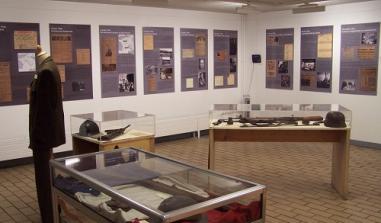Museum of 20th Century History
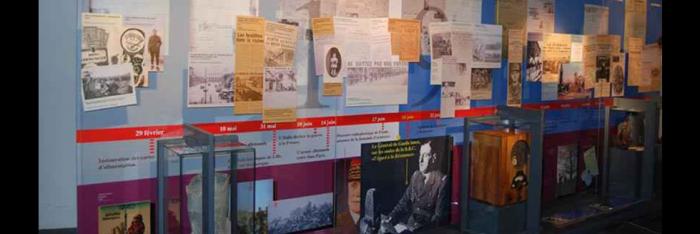
Une salle du musée du XXème siècle. Source : site de la commune d'Estivareilles
This museum, which was designed as a place of remembrance as well as an educational and cultural institution, is in the Forez Art and History District in the Loire.
The Museum of 20th Century History is more than a memorial about the August 1944 episode in Estivareilles; it is place to ponder and discuss contemporary issues, in particular human rights, in the light of past events. The museographic exhibition has been designed to be accessible to all, especially young people. Estivareilles, a town of 500 people 900 metres above sea level in the Saint-Bonnet-le-Château area, is in the Forez Mountains and the Loire department, 40 km from Saint-Etienne, 60 km from Le Puy-en-Velay and 100 km from Lyon.
A museum, a place, a village In the heart of the town, the former convent buildings of the Congregation of the Sisters of Saint Joseph, houses the new Museum of the 20th Century. The north wing's renovation marks the end of the restoration project of the site, which now includes the town hall, rental housing units, tourist accommodations, a car park and a central garden that gives the complex a sense of unity.
An amazing achievement: the museum of history of the twentieth century Estivareilles, a hotbed of resistance
In late August 1944, the small town of Estivareilles trembled. A heavily armed German column had left the Romeuf barracks in Puy-en-Velay and was bearing down on St. Etienne. The St Etienne-Le Puy train track was cut at Pertuiset and, due to the actions of the Resistance, the main roads were unsafe. The Nazi column, desperate and willing to do anything, took the ridge roads, harassed by Wodli's F.T.P.F. resistance forces in Saint-Paulien, Bellevue-la-Montagne, Chomelix and Craponne-sur-Arzon. Estivareilles. The Loire Secret Army took its position. Local Resistance fighters converged on the small town in Haut-Forez. After the Liberation of St. Etienne on 19 August, the population was in grave danger. And Commandant Marey (head of the Loire Secret Army) decided to stop the Germans in Estivareilles! The surrender was on 22 August. 1984: creation of a museum Forty years later, the departmental museum of the Secret Army and the Resistance opened to the public in the presence of Lucien Neuwirth, a major Resistance figure and president of the Loire General Council. This project, which the veterans of the Loire Secret Army (a non-profit association) initiated and carried out, is supported by Estivareilles' elected officials.
Modernisation and reorganisation: the Museum of 20th Century History
On 21 May 1999, Jean-Pierre Masseret, Defence Minister with responsibility for veterans' affairs, inaugurated the new museum. Founded in 1984 by the Loire Secret Army veterans, the museum was entirely renovated in 1999 to open up to new generations. The Museum of 20th Century History was designed as a place of remembrance but also as a cultural and educational institution. It is more than a memorial about the August 1944 episode in Estivareilles; it is a place to think about and discuss contemporary issues in the light of past events. The museographic exhibition has been designed with the goal in mind of being accessible to everybody, especially young people. Come and (re)live the adventure of the 20th century by visiting modern, interactive museums. The displays include historical objects, sound tracks, newsreels, pictures and videos adapted to the whole family. The museum's storerooms contain precious journals and "scrapbooks" made by the Resistance members themselves. The first-hand accounts map out a geography of personal memory that, combined with others, make up our collective memory - in other words, history. Showing a few powerful videos of the last surviving veterans lets us pay tribute to the fighters while passing down to younger generations the values of the Resistance and showing how a historical event becomes part of the nation's heritage. The museum's storerooms also contain the Charreton collection, a group of items from the Dora-Commando camp at Buchenwald. A former camp inmate gathered these documents during his many journeys of remembrance back to the former camp. The museum offers a year-round programme of temporary exhibitions, lectures and meetings.
The museum's cultural project Four key goals underpin the museum's cultural project: Testifying. Today we are lucky to work with generations who can remember the first half of the 20th century, in particular Resistance members and former concentration camp inmates. Their involvement is essential and precious. The light they cast on history gives our thoughts meaning, sensitivity, feeling and humanity. Explaining. The museum's historical, chronological approach to the entire century enables us to understand the facts, reasons and dates. The Resistance and the horror of the Deportation stand in the middle of the 20th century, between the emergence of industrial societies and the First World War at one end and European integration on the other. The museum puts all these events into perspective and context in order to help us understand history better and learn the lessons that the past has to teach us. Transmitting. This new place of history will pass down to young generations knowledge about the 20th century's major conflicts and events, but also to perpetuate the memory of the former Resistance members and the ideals for which they fought and died.
Reflecting. Lastly, by re-interpreting our past, we seek to question the present and today's world. This site is more than a place of remembrance and a history lesson; it offers testimonials by people who actually took part in the events and the viewpoints of historians to help foster a debate on our present in the light of the Resistance and of past events. A state-of-the-art museum The thoroughly modern museum has been designed to recount the 20th century in an attractive, instructive way. Interactive systems, sound recordings, videos and lighting combine with historical rigor in the treatment of the 20th century's darkest days. Visitors become actors and appropriate the site, objects and presentation. Young people, a special public The museum wants to really reach young people. That is a hard goal to achieve because they have stubborn prejudices about museums. The displays, education department and teaching kit have been designed with that in mind. Each year for the "National Résistance and Deportation Competition" in middle and high schools, the museum produces a dossier to help students in their research. This kit, which is non-exhaustive of course, features texts, documents (adapted to the subject of the competition) and a summary bibliography that can be consulted at the museum. The museum's archives, library and video library are open to the participants by appointment.
Temporary exhibitions The temporary exhibitions help to implement the museum's cultural policy in the public sphere. For example: The Voices of Memory "I remember our dying friends asking us, If you make it back, promise you'll talk about us...'" (Violette Maurice. Resistance member deported to - Ravensbrück, block N.N.)
2005 -1945 "60th anniversary of the camps' liberation" As part of the 60th anniversary of the camps' liberation, the Museum of 20th Century History wanted to pay tribute to the deportees of the Loire Department and, through them, to all the deportees. Moving testimonials by the last surviving witnesses of those unspeakable horrors will have helped us better understand what the deportees endured in the Nazi concentration camps. Poems, songs, drawings and even making everyday objects were acts of Resistance in themselves (possessing personal belongings was forbidden). 1914-1918 - crossing glances
Looking back at the Great War, 90 years later To open our cultural season (spring 2006), we are offering visitors an exhibition devoted to the Great War presenting drawings, paintings and watercolours made between 1914 and 1918. At the same time, local contemporary artists expressed their vision of the same event, 90 years later.
"1944-2004" -60th anniversary of the fighting in Estivareilles and the liberation of the Loire Department. This exhibition -a "tribute to the Resistance members" - traces the "battle of Estivareilles" from the widest possible point of view by putting those days in August 1944 into the context of the war's history on the national, regional and local levels (Puy-en-Velay, Givors, Saint Etienne, etc.). A series of conferences, a guided tour of the places where the fighting took place, meetings with Resistance veterans and the publication of Estivareilles 1944 - mémoire d'un été singulier (Estivareilles 1944 - Remembering a Singular Summer) putting the "battle of Estivareilles" into the context of the war's history on the national and local scale marked the occasion.
Museum of 20th Century History - Resistance and Deportation
Rue du couvent - 42380 Estivareilles
Tel.: 04.77.50.29.20
E-mail: museehistoire.estivareilles@wanadoo.fr
Opening hours and rates
The museum is open every day, all year-round from 2 p.m. to 6 p.m.
Adult : 3.10 € Heritage Passport: 2 € Child (8 - 16 years old): 1.50 € Child (under 8): Free A document explaining the visit is provided for 6- to 13-year-old children.
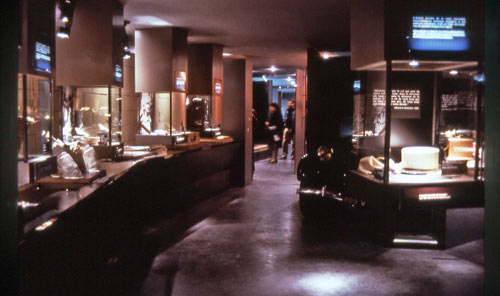
Musée espace 39/45. Source : site de l'Office de Tourisme de Saint Bonnet le Château
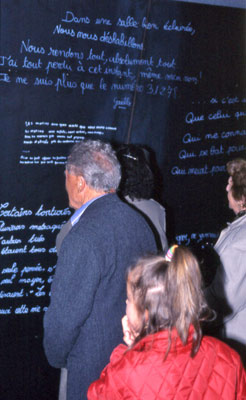
Mur de la mémoire. Source : site de l'Office de Tourisme de Saint Bonnet le Château
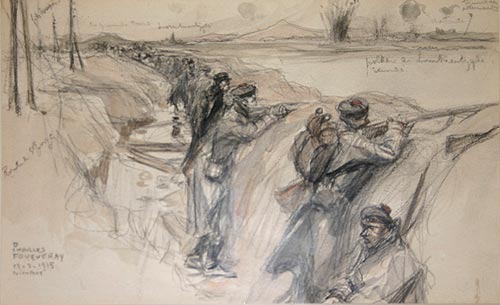
Soldats dans la tranchée - Dessin aquarellé -12.02.1915. Photo Charles FOUQUERAY - Source : site de l'Office de Tourisme de Saint Bonnet le Château
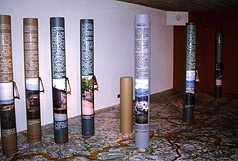
Vue de l'exposition temporaire. Source : site de l'Office de Tourisme de Saint Bonnet le Château
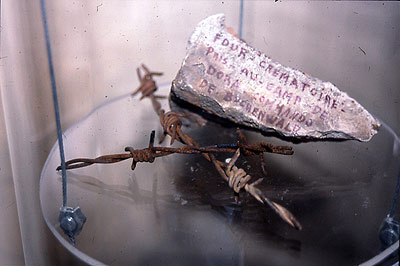
Vue expo n°3 - Pierre du four crématoire de Buchenwald. Source : site de l'Office de Tourisme de Saint Bonnet le Château
Practical information
Rue du couvent 42380
Estivareilles
04 77 50 29 20
Adulte : 3,10 € Passeport Patrimoine : 2 € Enfant (8 - 16 ans) : 1,50 € Enfant (-8 ans) : Gratuit
De 14h à 18h
Fermé les samedis et lundis du 12 novembre au 31 mars, le 25 décembre et 1er janvier


